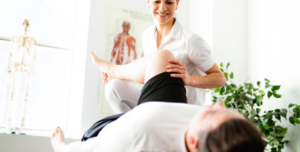Physiotherapy can accelerate healing, help achieve an ideal outcome and speed the return to sport. Your therapist will assess the extent of damage sustained and identify which muscle(s) have been injured.
Calf strains should be rested for several days (grade 1) until the pain subsides, without massage, as this may damage new blood vessels and increase bleeding. Once the pain has subsided, your physiotherapist will prescribe various strength exercises.
 Your calf muscles sports physio Adelaide physiotherapist can guide you with exercises designed to strengthen your calves without aggravating an existing injury. They’ll show you techniques to minimise discomfort during workouts and how to adapt exercises as necessary – strong calves are vital in returning blood towards the heart during activity, known as “venous return”.
Your calf muscles sports physio Adelaide physiotherapist can guide you with exercises designed to strengthen your calves without aggravating an existing injury. They’ll show you techniques to minimise discomfort during workouts and how to adapt exercises as necessary – strong calves are vital in returning blood towards the heart during activity, known as “venous return”.
Strengthening
Calf muscles (gastrocnemius and soleus) are responsible for foot flexion, walking and running. As powerful muscle groups attached directly to the heel via Achilles tendon, they play an integral role in preventing lower leg injuries like Achilles tendonitis, shin splints and strains.
If you injure your calf muscle, seeking medical assistance immediately reduces risk and speeds up recovery time. Seeking early treatment through physiotherapy will also lower risk and speed recovery from these types of injuries.
Grading muscle injuries based on size is important. Grade 1 describes small tears that cause mild pain but allow you to continue participating in activities without serious limitation or reduced performance, while grade 2 involves multiple muscle fibres being damaged, causing more severe discomfort with reduced performance and reduced performance overall. Finally, grade 3 involves larger tears in muscle fibres, leading to significant impairment and potential hematoma (blood clot). Seek medical assistance immediately as this constitutes a medical emergency, as early treatment can reduce risks such as life-threatening complications associated with such injuries.
Stretching
The muscles must remain flexible and strong for optimal calf health and avoid strains. Stretching regularly is one effective way of doing this, while wearing appropriate footwear for exercise and sports can help decrease stress on calf muscles.
Tight calf muscles may contribute to overtraining (when the load placed upon a muscle exceeds its capacity) and result in pain in the calves. Symptoms typically develop gradually and may include tightness and increased pain with running or cramps that often accompany training sessions. Cramps can often be caused by factors like fatigue, poor training technique, changes in loading, lack of rest or dehydration – and fatigue itself!
Taping/Wrapping
Taping can help ease the stress on an injured calf muscle by supporting it during activities that may aggravate it, such as physical therapy or sports activities. Your physical or occupational therapist may suggest taping techniques that help the gastrocnemius muscle (the largest of your calves).
First, apply a pre-wrap to protect the skin and improve tape adhesion. Next, create support strips by cutting pieces of tape extending beyond your calf muscle’s width. Attach these horizontally along your calf muscle, overlapping by half their width before spraying a thin layer of skin adhesive spray over your tape to enhance adhesion.
These tape techniques enable you to start exercising the calf muscles again while providing support to both muscle and tendon, but be wary about returning too quickly as this could increase the risk of further injuries. Allow enough time for healing before engaging in activities again, as too soon a return could compromise full healing, leading to another injury risk.
At the core of any successful rehabilitation is including stretching and strength training exercises to strengthen and lengthen calf muscles, decreasing chances of reinjury in the future. Plyometric strengthening exercises like repeated jumping may build powerful and explosive strength, preventing injury and boosting performance during sports or daily activities.
Massage
While we often consider the calf muscles tight, they possess considerable flexibility and can be easily stretched. If your calves feel particularly stiff or sore, a massage could be necessary to relax them and ease any tightness or tension.
Massage can be an invaluable aid for muscle injuries, stimulating blood flow and breaking up tight sections in muscles known as trigger points – knots that cause pain and decreased flexibility – with regular sessions with either hands-on massage or using specific tools like foam rollers.
